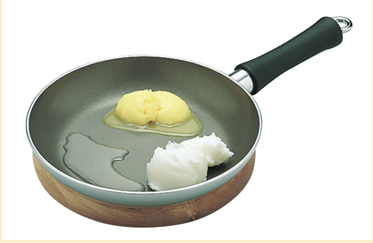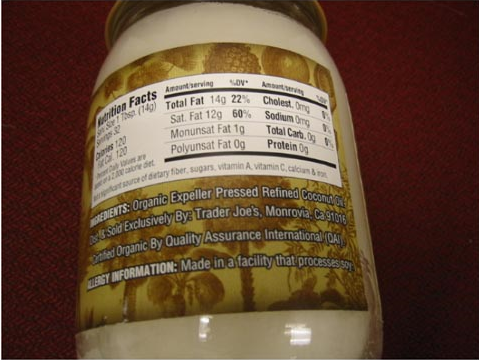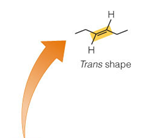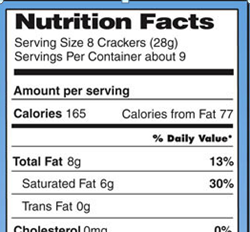|
Next in your lecture outline it outlines the different types of fatty acids. What I want you to know for each fatty acid is a little bit about its chemistry, what foods you predominately find these fatty acids in, and how they affect heart health. Click on the following link to view a powerpoint presentation to help you fill in the lecture outline on the different types of fatty acids.
http://www.screencast.com/users/Tamberly/folders/Jing/media/04350d1a-fb50-42bf-af78-6afe709d7d3e
The power point presentation had this image and I said that the liquid oil would be polyunsaturated and the yellow fat would be monounsaturated. That is not completely correct A highly mono or polyunsaturated fat would be liquid at room temperature. For example olive or corn oil. However a fat that is more saturated, but still contains high amounts of monounsaturated fatty acids (like chicken fat) would look like the yellow fat below. And a fat that is highly saturated, like coconut oil would look like the white fat below.
Saturated Fatty Acids
are a stable and compact way for a plant or an animal to store fat for later use as energy. Animals in the
wild
don't have a chance to store very much fat since they constantly need an energy source to live. On the other hand, animals that spend much of their time on
feedlots
, such as beef cattle, are inactive and therefore store a lot of saturated fat. So while deer meat is a very small source of saturated fat, most beef purchased in a grocery store is high in it. Foods that have mostly saturated fatty acids, like butter, are
solid at room temperature
and can
raise risk
of heart disease because they increase blood cholesterol, specifically the LDL or "bad" cholesterol. (More on this later). Food sources of saturated fatty acids include most animal fats, tropical oils, and partially hydrogenated oils.
Omega-
6
Un
saturated Fatty Acids (PUFAS)
- This is the type of fatty acid made by plants for storage and is the most common unsaturated fatty acid we usually get when we eat the oil of seeds, such as corn oil or soybean oil or corn oil. Michael Pollan, who wrote
The Omnivore's Dilemma
, says that omega-6s are involved in the rigidity of cell walls, clotting and the inflammation response.
Omega- 3 Un saturated Fatty Acids (PUFAS) - In the last decade, we have come to a much deeper understanding of this kind of unsaturated fatty acid. An omega-3 fatty acid is even more unsaturated than other unsaturated fatty acids and has special functions in our body. Some plant foods like flax seed have one type of beneficial omega-3 fatty acid (short chain ones) while some wild fish (like salmon) have still another type of beneficial omega-3 fatty acid (long chain ones). Most people associate omega-3 fatty acids with fish, but fish get them from green plants (specifically algae), who use them during photosynthesis. Pollan says they “appear to play an important role in neurological development and processing, the permeability of cell walls, the metabolism of glucose and the calming of inflammation.” Since the two fatty acids compete with each other for the attention of important enzymes, the ratio in the diet between omega-3s and omega-6s may matter more than the absolute quantity of either fat. Thus too much omega-6 from oils like corn oil may be just as much a problem as too little omega-3. |
|
As you can see from the illustration below, there is a mixture of all fatty acids in fats, and oils, and therefore foods. It can be confusing when we say that olive oil is a monounsaturated fat because that makes it seem like there are no saturated or polyunsaturated fatty acids present. What would be more correct is to say that olive oil is predominately a monounsaturated fat, but it does contain other fatty acids as well as you can see from the illustration.
Looking at the illustration below, which dietary fat is the most saturated? Click here to see answer.
|
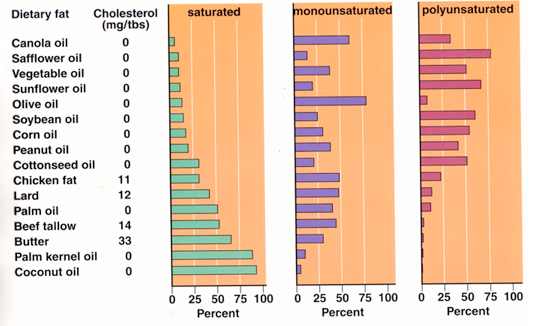 |
|
As you can see from the label below 12g out of the total 14g of total fat (in 1Tbsp. of coconut oil) are saturated. Notice that there is 0mg of cholesterol. That is because only animal fats contain cholesterol, not plant fats.
|
The two
essential
fatty acids are linoleic acid and linole
n
ic acid. Below is linoleic acid, which is an omega-
6
fatty acid.

Linoleic acid Linoleic acid (above) is more common in the seeds of plants. The first double bond is after the 6th carbon starting on the left. Below is another way of representing linoleic acid: 
Below is the other essential fatty acid, linole n ic acid, which is an omega- 3 fatty acid. 
|
The fatty acids represented below are not considered
essential
because we can make them from the essential ones. But having good levels of them in your diet appears to decrease the risk of heart disease.
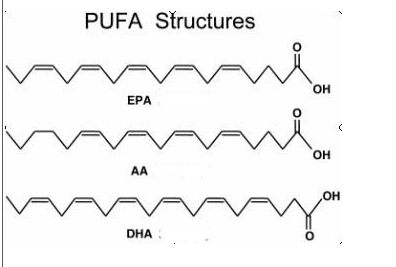
|
|
By no means is it important to know the names of all of the fatty acids in the following table. This table was made to illustrate a little about the wide diversity of fatty acids in foods, and how those fatty acids effect blood cholesterol.
|
Chemical Names and Descriptions of some Common Fatty Acids and the Effect they have on Cholesterol
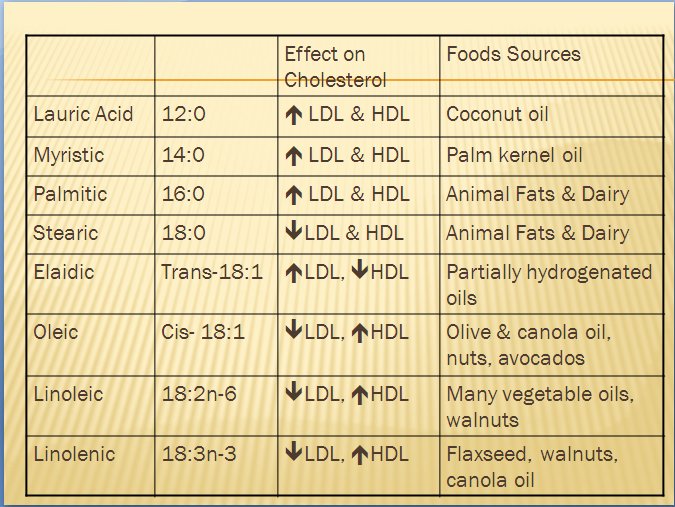
|
The first four fatty acids are saturated fatty acids. Notice that the first three (Lauric, Myristic, and Palmitic) have a negative impact on blood cholesterol levels (increasing LDL levels), but they ALSO have a positive impact as well (increasing HDL levels). Saturated fats get a bad reputation for being unhealthy, but recently there has been more information stating that the link between saturated fat and heart disease may not be as strong as we once thought. In an article from Tufts University Health & Nutrition Letter (May 2010), Links Between Saturated Fat, Blood Cholesterol & Heart Disease Prove Complex, a researcher from Children's Hospital Oakland Research Institute, Ronald M. Krauss, MD stated that, "Our meta-analysis showed that there is insufficient evidence from prospective epidemiological studies to conclude that dietary saturated fat is associated with an increased risk of cardiovascular disease (CVD)." Researchers state that one reason reducing saturated fat intake may not decrease CVD risk is because people tend to replace saturated fat with processed carbohydrates. "An overall eating pattern that emphasizes whole grains rather than refined carbs such as white flour, along with foods high in polyunsaturated fats, such as fish, seeds, nuts and vegetable oils, is of more value for reducing coronary heart disease risk than simply aiming to further reduce saturated fat," states Krauss.
The message really is to displace saturated fat with unsaturated fat, and to eat a balanced diet with a variety of whole foods.
Trans Fatty Acids
More About Hydrogenated Fats: In an attempt to find an inexpensive substitute for butter, as far back as 1903, Britain was adding hydrogen gas to liquid (polyunsaturated) oils in a process called hydrogenation. This hydrogen reacted with the double bonds in the structure of the unsaturated fatty acids of the corn oil. Hydrogenation creates both saturated and trans fatty acids. Not only did this make the oil
solid
at room temperature (so margarine and shortening were possible from oils like corn oil), it also
preserved
them by making the oil more stable and less likely to go
rancid
(so baked goods like cookies and chips would have a longer shelf life).
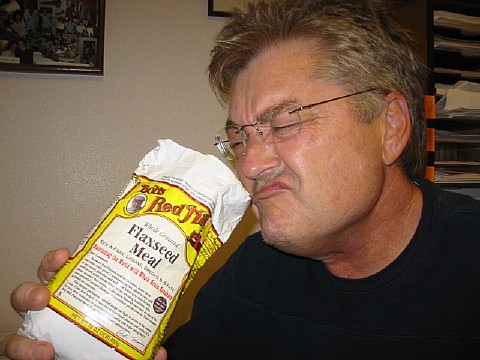
So why is the above flaxseed meal especially prone to rancidity, leading to a distasteful smell for my colleague Roger Hecht? Flax seed contains a fatty acid that has 3 double bonds. As said above, rancidity is when oxygen attacks double bonds. With more double bonds, more rancidity happens.
Flaxseed meal is a wonderful food but it should be refrigerated to keep it from going rancid.
When concerns arose in about the 1970s and 1980s about the saturated fats in the palm and coconut oils used in baked goods and margarine (in part because they were cheaper than butter) they were often replaced with these hydrogenated fats made from oils from corn and soybeans. When used in cookies or potato chips instead using an oil like corn oil that contains polyunsaturated fats, the product had a longer shelf life. And products like margarine made with corn oil were solid similar to butter. McDonald's and Kentucky Fried Chicken found the hydrogenated fats gave a wonderful crispness to their French fries and chicken that was difficult to replace. Jif liked the smooth “mouth feel” small amounts of it added to their peanut butter. |
| Video Clip for the Lecture Outline about
Hydrogenation plus B. Phospholipids C. Sterols approximately 7 minutes |
| As the Lecture Outline says, plants make sterols, but not cholesterol. An article in the journal
Nutrition Today
about pistachios said
"Among tree nuts, pistachios are the richest source of phytosterols, particularly beta-sitosterol and campesterol."
"Phytosterols are plant sterols, which compete with cholesterol in the intestinal lumen for uptake into the bloodstream, and phytosterols may reduce cholesterol levels."
"The Pistachio: A Surprising and Colorful Nut"
David Hever, MD, PhD Susan Bowermanm MS, RD Nutrition Today Jan/Feb 2008 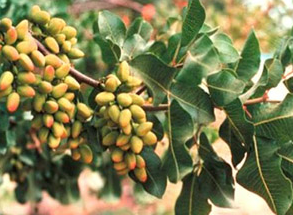
The article said that pistachios are botanically related to cashews and mangos (!).
Although they are native to the high deserts of West Africa and the Middle East, our neighbor California now grows them. |
|
So which fat is best to eat?
The best way to get fatty acids is in WHOLE foods, as you're also getting a variety of vitamins, minerals, phytochemicals and sometimes fiber and protein. And consuming a lot of refined fats, whether it be in butter, olive oil or margarine can lead to an excess of a particular fatty acid that can be detrimental to health. There are definitely times, though, when we may prefer something that is not whole, like when we have a nice slice of toast or we're wanting to stir-fry vegetables. For bread and toast, what I prefer is butter, and the first reason for that is a personal preference for the taste of butter. Just a little bit goes a long way and I don't think a little bit of butter is going to raise my risk of heart disease, especially when there are also plenty of fruits, vegetables and whole grains in what I eat. For sautéing and other uses, I like to use canola oil. It can be heated to a high temperature, plus it does not have any flavor so you can use it for baking. It also contains Omega 3's which can help balance out the Omega 6's you find in soybean and corn oil that is the main oils used in a lot of processed foods. For salads and other uses, olive oil is great and we always have it on hand. I buy the less refined "Extra Virgin" olive oil that has a green color and a stronger flavor from the phytochemicals that are present. |
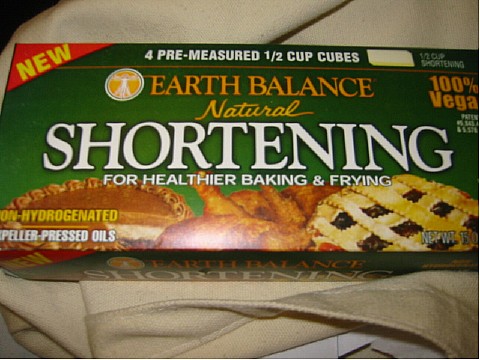
|
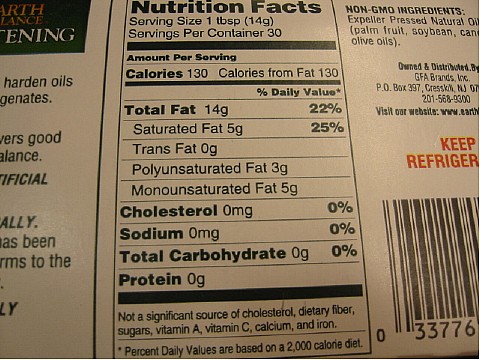
Since margarine companies want to advertise their product as having no hydrogenated fat and no trans fat, they have been using other ways of making their margarine solid and spreadable. What some companies are choosing to use are things like palm "oil", which is high in saturated fat.
|
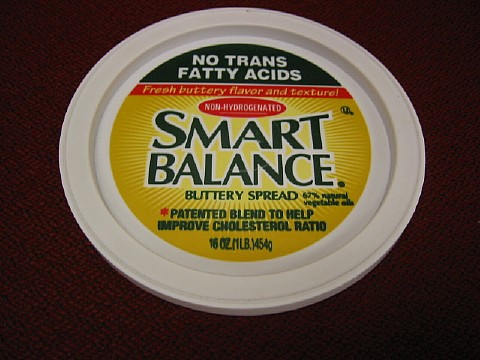 |
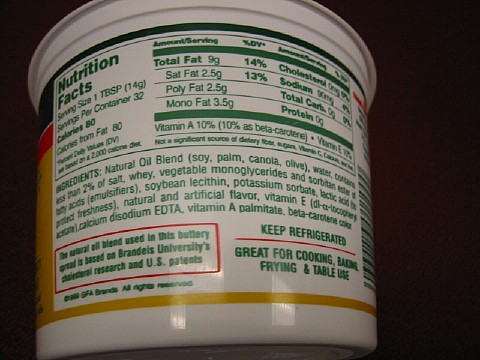 |
|
In a search for another way to make stable oil yielding crispy deep-fried products (and one using something American farmers can grow), some products are being marketed as “low-linolenic” and “high-oleic”, although I haven't seen them yet.
The American Heart Association has a website with some General Information for restaurants including:
What do you mean by “low-linolenic” and “high-oleic” oils, and how were they developed? These terms describe a newer class of oils made from traditional plant sources, such as canola, soy, safflower, corn, sunflower, etc. These oil seeds have been bred, through conventional plant breeding and genetic engineering, to produce oils that are just as stable as partially hydrogenated oils that contain trans fats. You can use them in a commercial kitchen the same way you use oils containing trans fats, i.e., mostly in heavy-duty frying and baking applications. Traditional liquid vegetable (non-tropical) oils and these newer oils are healthier choices, because they are trans fat-free and low in saturated fat.(
Note from Instructor
- Looking at the above chart of fatty acids, you can see that linolenic acid is not only a beneficial essential fatty acid, it is also a beneficial omega-
3
fatty acid.)
Should I use the newer “low-linolenic” or “high-oleic” oils for all of my frying applications? If you do only light or medium duty frying such as sautéing or pan frying or do deep frying only occasionally, we suggest you try one of the traditional liquid vegetable oils first. If that does not meet your needs or you do a lot of deep frying throughout the day, then we recommend you use these newer “low-linolenic” or “high oleic” oils to replace trans fats in your kitchen and in the same applications for which you have used partially hydrogenated oils containing trans fats. To further clarify, if you have used trans fat oils for your deep-frying applications, we encourage you to switch to healthier 0 grams trans fat oils such as these low-linolenic or high-oleic varieties. For light or medium-duty applications such as salad dressings where you have never used oils that contain trans fats, we encourage you to stay with your current oils. |
||||||||||||||||||||||||||||||||||||||||||||||||||
These lectures have often said that WHOLE foods are usually the best way to get nutrients. Just look at the nutrients in pistachios, listed in the previously mentioned article.
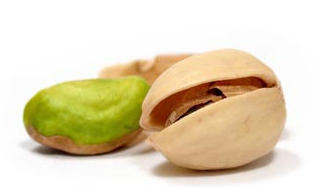
Using the "MAGIC DV", which nutrients would a serving of these pistachios be a good source of?
Our local filberts are just as nutrient dense as these pistachios are. |
